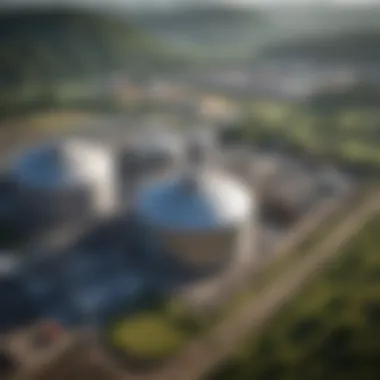Biogas Power Plants: Insights into Renewable Energy


Intro
Biogas power plants stand as a bridge between traditional farming practices and modern renewable energy solutions. In today’s world, where the quest for sustainable energy sources is sharper than ever, these plants play a vital role in harnessing energy from organic waste. They transform materials like animal manure, food scraps, and agricultural residues into biogas, a combustible gas that can generate electricity and heat. This process not only contributes to the reduction of greenhouse gases but also presents an opportunity for farmers and agricultural enthusiasts to improve their operations economically and environmentally.
Topic Overview
Definition and Importance
At its core, a biogas power plant is a facility where organic materials are broken down anaerobically by microorganisms to produce biogas. This biogas is primarily made up of methane, carbon dioxide, and small amounts of other gases. It serves as a renewable energy source that can replace fossil fuels. The importance of biogas plants extends beyond energy production. They offer a sustainable waste management solution, enhance soil health through digestate application, and support the circular economy in agriculture.
Brief History and Evolution
The concept of converting organic waste into energy isn't new. Historical records indicate that anaerobic digestion was practiced as early as the 19th century. However, the modern biogas power plant has evolved significantly thanks to technological advancements and increased awareness of environmental issues. Early installations were often small and rudimentary, primarily found in rural areas of developing countries. Nowadays, with the advent of large-scale industrial biogas facilities, countries are embracing biogas not just as a solution for waste disposal, but as a strategic component in achieving energy independence and sustainability.
Key Techniques and Innovations
Sustainable Farming Practices
Biogas power plants contribute to sustainable farming by utilizing organic waste that would otherwise pollute the environment. Farmers can feed their leftover Crops and livestock manure into the digester, turning waste into a valuable resource. This practice significantly reduces methane emissions from landfills and enhances nutrient recycling back to the land. Furthermore, the digestate produced serves as an organic fertilizer, improving soil health and boosting crop yields.
Advanced Agronomic Technologies
Several cutting-edge technologies have enhanced the efficiency of biogas production. For instance, co-digestion—where multiple organic materials are processed together—has been increasingly used to maximize biogas output. Innovations such as pre-treatment methods help break down materials more effectively, leading to greater gas yields. Monitoring systems and automated processes also improve operational efficiency, allowing for real-time adjustments in temperature, pH, and other critical parameters.
Practical Applications
Step-by-Step Guides
To understand the practical implementation of biogas plants, one can look at the pathways involved:
- Feedstock Collection: Gather materials like animal manure, food waste, or crop residues.
- Preparation: Ensure the feedstock is shredded or mixed to enhance digestion.
- Anaerobic Digestion: Feed the prepared materials into a digester where microorganisms break them down in the absence of oxygen.
- Gas Collection: Capture the produced biogas for storage or use.
- Digestate Management: Utilize the leftover digestate as a soil amendment.
Case Studies or Real-World Examples
Many farmers and agricultural businesses have reaped the rewards of installing biogas power plants. For example, a dairy farm in Germany implemented a biogas facility that processes manure from its herd of 200 cows. By doing so, they not only generated electricity for their operations but also significantly reduced their carbon footprint. This transformation not only improved their sustainability but also bolstered their public image in a market increasingly concerned with environmental impacts.
"The adoption of biogas technologies can turn an agricultural waste problem into an energy solution," says Dr. Angela Hart, an environmental engineer specialized in sustainable practices.
Biogas power plants, therefore, emerge as a crucial component in the broader narrative of sustainable energy and agriculture. As the landscape of energy production continues to shift, these facilities provide tangible benefits that resonate with farmers and environmentalists alike.
Prolusion to Biogas Power Plants
In the ever-evolving narrative of renewable energy, biogas power plants stand out as a beacon for sustainable practices and innovative solutions in waste management. The significance of biogas technology transcends mere energy production; it addresses vital concerns related to agricultural waste, greenhouse gas emissions, and resource recovery. Most farmers are familiar with composting, but biogas presents an advanced approach, transforming organic waste into both energy and a nutrient-rich byproduct.
Overview of Biogas Technology
Biogas technology hinges on anaerobic digestion, a process where microorganisms decompose organic material in the absence of oxygen. This process generates methane-rich gas, commonly known as biogas, which can be utilized for electricity generation, heating, or even as a vehicle fuel. The systems can vary from simple designs like small-scale digesters, ideal for individual farms, to large industrial setups that serve multiple industries. Key advantages of biogas technology include:
- Transforming waste into a usable resource
- Reducing reliance on fossil fuels
- Lowering greenhouse gas emissions
- Promoting soil health through digestate application
Understanding these mechanisms allows farmers and stakeholders to grasp the full scope of biogas's potential impact, not just on energy costs but also on enhancing the sustainability of their farming operations.
Historical Context and Development
The journey of biogas development spans centuries, with the earliest records tracing back to the 16th century when it was first observed that animal manure could produce flammable gas. Fast forward to the 19th century when the Gas Works emerged, primarily in urban areas, utilizing waste materials to produce town gas.
In the 20th century, specifically during the 1970s, the oil crisis spurred renewed interest in alternative energy sources, leading to the development of small-scale digesters for agricultural use. The 21st century witnessed a major revival as countries began to recognize the dual benefits of waste-to-energy solutions and climate change mitigation efforts. Countries such as Germany and India have pioneered biogas technologies, implementing policies that support biogas development as part of broader renewable energy goals.
The evolution of biogas power plants reflects a growing understanding of waste utility, showing how industries can innovate to meet energy demands sustainably. As this context unfolds, we witness the transformation of biogas from a historical curiosity into an essential element of modern energy landscapes.
Principles of Biogas Production
Understanding the principles of biogas production is fundamental for grasping how biogas power plants operate. This process doesn't merely convert organic materials into usable energy; it serves as a cog in the wheel of a larger sustainable system. By dissecting how biogas is produced, it becomes clear how this renewable energy source can mitigate waste and harness natural processes for energy generation.
Anaerobic Digestion Process
At the heart of biogas production lies anaerobic digestion, a biological process where microorganisms break down organic matter in the absence of oxygen. This process occurs in specially designed digesters that maintain optimal conditions for microbial activity. Here's what makes anaerobic digestion a cornerstone of biogas production:


- Energy Generation: The digestion process leads to the release of biogas, primarily composed of methane and carbon dioxide. This mixture can be harnessed to generate electricity and heat, or it can be refined to produce biomethane that fuels vehicles.
- Organic Waste Reduction: By utilizing waste materials — from agricultural residues to food waste — anaerobic digestion significantly helps in reducing the volume of waste sent to landfills. It's a practical solution to a pressing global issue.
- Nutrient Recovery: Digestion also produces digestate, a nutrient-rich by-product that can be used as a fertilizer on farms. This closes the nutrient loop in agriculture, promoting a cycle of reuse and restoration of soil health.
The process generally unfolds in several stages: hydrolysis, acidogenesis, acetogenesis, and methanogenesis. Each phase plays a vital role:
- Hydrolysis: Complex organic materials, like fats and proteins, are broken down into simpler compounds. This is where the fun begins, as microorganisms get to work!
- Acidogenesis: Simple sugars and amino acids are converted into volatile fatty acids, hydrogen, carbon dioxide, and more.
- Acetogenesis: The volatile fatty acids are then transformed into acetic acid, hydrogen, and carbon dioxide, creating a rich environment for methane-producing bacteria.
- Methanogenesis: This final stage is where methane is produced. Methanogenic archaea thrive in this anaerobic environment, creating biogas that can be utilized.
Microbial Communities Involved
Microbial communities are the silent workforce behind biogas production. The process of anaerobic digestion is not solely reliant on a single type of microorganism but rather a complex interplay among various species. These communities are categorized into several groups, each with distinct roles:
- Hydrolytic Bacteria: They initiate the breakdown of organic materials by producing enzymes that convert complex compounds into simpler monosaccharides and fatty acids.
- Acidogenic Bacteria: These guys take the simplicity of the hydrolytic stage one step further, fermenting the products into volatile fatty acids and other intermediates.
- Acetogenic Bacteria: They’re responsible for converting the fatty acids produced into acetic acid, which is crucial for the methanogenesis step.
- Methanogenic Archaea: This final group is essential as they convert acetic acid and hydrogen into methane and carbon dioxide. Without them, biogas wouldn’t be biogas at all!
The diverse interactions of these microbial communities are influenced by conditions such as temperature, pH level, and the composition of the feedstock. Any disharmony in this microbial orchestra could result in reduced efficiency in biogas production.
"The microbial partners sustain each other and create a flourishing system that mirrors nature's own recycling processes."
It is noteworthy that successful biogas production hinges on maintaining a balanced microbial ecosystem. Understanding this balance assists operators in optimizing the digestion process, allowing for a more efficient energy output while enhancing the overall stability of the biogas plant.
In summary, the principles of biogas production illustrate not only the technical aspects but also the intricate biological interactions that are pivotal to its success. It underscores the idea that energy production can go hand-in-hand with waste management and nutrient recycling.
Feedstock for Biogas Plants
Feedstock is at the heart of biogas production; without it, the entire system falls flat. Essentially, feedstock refers to organic materials that serve as the raw input for biogas plants. Different types of feedstock can significantly influence the efficiency of biogas production, the quality of the biogas generated, and the plant's overall sustainability. Understanding the feedstocks available can help farmers and stakeholders optimize their resources, making biogas technology not just a viable option but also a strategic one for managing waste and generating energy.
Organic Waste Materials
When it comes to feedstock, organic waste materials play a vital role. Think of kitchen scraps, food waste, and other biodegradable refuse. This category isn’t just about recycling leftovers; it’s an effective way to mitigate landfill overflow and reduce methane emissions. Some studies show that using organic waste can increase biogas yield by nearly 50%. Not only does this contribute to a cleaner environment, but it also provides an excellent return on investment for farms looking to diversify their income streams.
Consider this: instead of throwing away unused food or expired products, they can be transformed into energy. Farms that process organic waste may see a reduction in disposal costs. Also, the digested material can be used as nutrient-rich fertilizer, completing the cycle of sustainability.
Agricultural Residues and Manures
Agricultural activities leave behind various residues, such as straw, corn stalks, and rice husks. Additionally, animal manures from cattle, poultry, and pigs are incredibly rich in nutrients and can be utilized as effective feedstock. These materials are often seen either as waste or as a challenge to manage, however they can be a goldmine for biogas plants.
Manure, when utilized in biogas production, can reduce smell and pathogen levels in livestock waste. This process is two-fold: it helps farmers meet regulatory standards while also generating energy. In fact, converting manure to energy can help farmers reduce their reliance on fossil fuels and fossil fuel-derived fertilizers. Hence, understanding how these agricultural residues could contribute to renewable energy systems is essential for farmers.
Utilizing agricultural residues not only generates energy, but also solves waste management issues, making farms more sustainable and profitable.
Energy Crops and By-products
Not all feedstock comes from waste. Energy crops specifically grown for biogas production can provide consistent supply and high yields. Examples include maize, sorghum, and miscanthus. These crops have high biomass and energy content, making them particularly suited for biogas plants. While planting energy crops involves some initial investment, they can yield substantial returns, especially when market prices for energy fluctuate.
By-products from the food industry, such as vegetable peelings, expired dairy products, or spent grains from breweries, can also be viable sources of feedstock. These materials would otherwise contribute to waste but can be procured at low costs or even at no cost in some cases. When combined with agricultural residues and organic waste, they can optimize the overall output of the biogas plant.
Technology in Biogas Plants
The integration of technology in biogas plants is pivotal not only for maximizing the output of biogas but also for enhancing overall efficiency and sustainability. This section elaborates on the various technological frameworks that shape the operations of biogas facilities, focusing on the mechanics of production and the utilization of biogas generated. Understanding these healthily contributes to the advancement of biogas as a significant player within the renewable energy landscape.
Types of Biogas Digesters
Continuous vs. Batch Systems
When one dives into the operational aspects of biogas digesters, the choice between continuous and batch systems stands out. Continuous systems are designed to introduce feedstock regularly, ensuring a steady inflow and consequently, a consistent output of biogas. This system is akin to running a factory assembly line—smooth production without hiccups. Conversely, batch systems operate more like a cooking pot, where all feedstock is added at once, and the digester is sealed until the process is complete.
The continuous system is often favored for its efficiency; it allows for ongoing operation, leading to increased gas production over time. However, the batch system can be advantageous in situations where feedstock availability is inconsistent or when the operation capacity is small, as it allows for more tailored management of the digestion process. The selection between these systems hinges on factors such as operational scale, available feedstock, and desired gas output.
Above-ground vs. Below-ground Designs
Another critical consideration in the technology of biogas plants is the choice between above-ground and below-ground digester designs. Above-ground systems are typically easier and cheaper to construct and maintain, providing accessibility for monitoring and troubleshooting. These designs can often support insulation and temperature control, which is paramount for effective digestion. However, they may be subject to weather conditions which can affect their efficiency and longevity.
On the flip side, below-ground digesters offer greater stability against environmental factors, including extreme temperatures. They usually require more capital for excavation and construction but present a lower visual impact, which is often favorable for permitting processes. The decision between these two designs reflects not only the economic considerations but also the specific site characteristics and local regulations.
Gas Utilization and Conversion
Combined Heat and Power (CHP)
Combined Heat and Power systems represent a robust approach to utilizing biogas. By converting biogas into both electricity and useful heat, CHP systems enhance the overall energy efficiency and value derived from biogas production. One of the central advantages of CHP is its ability to deliver electricity exactly where it’s needed, minimizing losses associated with transmission. Furthermore, the heat generated can be used for various applications, including heating buildings or engaging in processes that require significant heat input.
The limitation, however, might be the initial investment costs which can deter some smaller operations. Nonetheless, the long-term savings on energy costs and the environmental benefits tend to offset these initial expenses, making CHP a cornerstone technology in the biogas industry.
Biogas as a Vehicle Fuel
Using biogas as a vehicle fuel is gaining traction and shines as a remarkable application of this renewable energy source. Biogas can be upgraded to biomethane, achieving a quality similar to natural gas, thus allowing it to power vehicles effectively. This option not only provides an alternative to fossil fuels but also improves energy security.
However, the conversion infrastructure and vehicle compatibility remain hurdles. Not every vehicle can run on biogas in its raw form without significant modification. Yet, the environmental gains from using biogas as a transportation fuel can be substantial, reducing reliance on traditional fossil fuels and lowering greenhouse gas emissions in the transportation sector.
Biogas technology is not just about waste management—it's about transforming waste into wealth and energy.


Environmental Benefits of Biogas Power Plants
Biogas power plants are more than just a means of generating energy; they play a crucial role in fostering environmental sustainability. Their ability to transform waste into energy not only helps in meeting energy demands but also addresses significant ecological issues. Below are the key environmental benefits associated with biogas power plants, providing a clear picture of why they are essential in modern energy conversation.
Reduction of Greenhouse Gas Emissions
One of the notable advantages of biogas power plants is their capacity to reduce greenhouse gas emissions. Traditional energy sources, like fossil fuels, release substantial amounts of carbon dioxide and methane when burned. In contrast, biogas systems convert organic waste materials into energy through a process known as anaerobic digestion. This process notably captures methane, a potent greenhouse gas, before it can escape into the atmosphere.
According to estimates, biogas plants can effectively reduce methane emissions by about 90% compared to untreated organic materials. This is particularly significant since methane has a global warming potential far exceeding that of carbon dioxide—about 25 times more potent over a 100-year period. Therefore, by harnessing methane for energy use, biogas plants help mitigate climate change.
"Harnessing the potential of waste not only produces energy but also decreases harmful emissions, making our planet a bit healthier."
Waste Management Solutions
Waste management is a pressing concern in today's society. Landfills are overflowing, and the incineration of waste can contribute to air pollution. Biogas power plants present an innovative solution to these challenges. By treating organic waste—such as agricultural leftovers, food scraps, and manure—these plants reduce the volume of waste sent to landfills.
Biogas technology allows for the recycling of organic waste into valuable resources, such as biogas and digestate. Here's how it works:
- Organic Waste Collection: Farmers and food processors can divert waste from landfills by sending it to biogas facilities.
- Anaerobic Digestion: Within biogas plants, this waste undergoes anaerobic digestion, breaking it down to produce biogas and digestate.
- Resource Recovery: The biogas generated can be converted into electricity, heat, or even fuel, while the digestate can be used as fertilizer, enriching soil rather than harming it.
This cycle reduces landfill waste and supports a more circular economy.
Nutrient Recycling and Soil Health
Biogas power plants contribute to enhanced soil health through the process of nutrient recycling. The by-product of anaerobic digestion, known as digestate, is rich in essential nutrients. When applied to fields, it offers several benefits:
- Soil Fertility: Digestate contains nitrogen, phosphorus, and potassium—nutrients vital for plant growth.
- Improved Soil Structure: The organic matter in digestate helps improve soil texture, enhancing its ability to retain moisture and nutrients.
- Reduction in Chemical Fertilizer Use: By providing a natural alternative to chemical fertilizers, digestate can help reduce dependency on synthetic inputs, promoting a healthier ecosystem.
Farmers who adopt biogas technologies thus not only save on fertilizer costs but also contribute to sustainable agricultural practices. The integration of nutrient recycling reinforces the concept that waste can indeed turn into a valuable resource when managed effectively.
Economic Viability of Biogas Power Plants
Understanding the economic viability of biogas power plants is essential for anyone considering investment or operational engagement in this sector. It not only influences the decision-making process for potential stakeholders but also shapes the overall sustainability of the biogas industry. Numerous factors come into play when assessing this viability, including initial investments, operating costs, potential revenues, and the financial incentives offered by governments.
When examining the scope of biogas power plants, one must recognize their potential to create long-term economic advantages while also reducing waste and generating clean energy. These plants can transform organic waste into a valuable resource, aligning economic interests with environmental responsibilities.
Initial Investment and Operating Costs
The initial investment required for a biogas power plant can be quite significant. Several elements contribute to this overall expense:
- Site Preparation and Construction: Building a biogas facility involves substantial groundwork and specialized construction to ensure it operates effectively and safely.
- Equipment Costs: Digesters, gas storage systems, and associated machinery represent major components of the financial outlay. For instance, a complete anaerobic digester system can range from tens of thousands to millions of dollars, contingent on its size and capabilities.
- Permitting and Regulatory Expenses: Navigating the legal landscape is crucial. Securing permits and complying with local regulations initially requires both time and money.
Despite these upfront costs, it’s imperative to factor in the operating costs which can vary broadly based on sizes, technology, and feedstock. Regular maintenance, staffing, and utilities are some of the continual expenses to keep in mind. Properly managing these costs—not to mention optimizing operational efficiency—can yield a favorable financial outcome over time.
"A deep understanding of both initial and ongoing costs ensures stakeholders can evaluate their potential ROI effectively."
Revenue Generation and Subsidies
Once established, a biogas power plant can generate revenue through various channels, making it important to delve into its profit-making aspects. Key ways to generate income include:
- Electricity Sales: Selling power back to the grid can be a mainstay. In some regions, regulations provide incentives for renewable energy production, often resulting in enhanced returns on investment.
- Heat Recovery: Biogas production processes often yield excess heat, which can be harnessed for additional energy efficiency or even sold.
- Digestate Utilization: The byproducts following anaerobic digestion—known as digestate—can serve as a nutrient-rich organic fertilizer, creating another revenue stream for farmers and plant operators.
Moreover, various government subsidies and grants are available to encourage biogas initiatives. These financial supports are key to making projects feasible, especially in areas where financing methods are still catching up with technology. It’s beneficial to stay abreast of local and international policies that might influence financial stability and growth.
Challenges in the Biogas Industry
The biogas industry, despite its potential, faces a myriad of challenges that hinder its full realization. Understanding these obstacles is vital for farmers, investors, and policymakers aiming to adopt or support biogas technology. These challenges can significantly impact the efficiency and viability of biogas power plants, affecting their output and sustainable operations. By tackling them, stakeholders can maximize the benefits of biogas production and enhance its role in renewable energy generation.
Technological Limitations
While biogas technology has evolved, it still grapples with some noteworthy limitations. One major issue is the efficiency of anaerobic digestion systems. Existing digesters often struggle with handling high solid concentrations. This can lead to lower biogas yields and, subsequently, impact the bottom line. Additionally, many biogas facilities operate below optimal conditions due to the inconsistent quality of feedstock. Farming practices that don't prioritize sustainability can worsen this effect, leading to reduced methane production.
Furthermore, the technology for upgrading biogas to pure biomethane remains costly and complex. Farmers interested in investing might find it daunting when faced with high capital costs for advanced gas cleaning systems, making them hesitate or abandon their projects outright. Integrating newer technologies can yield better results but requires both training and resources, which may be lacking in many regions.
Regulatory and Compliance Issues
Navigating the regulatory landscape can feel like running a marathon in joggers. The rules governing biogas power plants often vary from one area to another, creating uncertainty and frustration for operators. Many countries have set up stringent environmental standards that must be met to operate a biogas plant. Complying with these regulations not only takes time but also demands additional financial resources.
Moreover, obtaining permits can be a lengthy process. Some farmers might find themselves waiting months or even years to get the green light for their operations. This delay can stifle innovation and investment in biogas technologies, as potential operators become discouraged. Moreover, inconsistencies in policy enforcement can lead to skepticism among local communities and hinder their willingness to support these initiatives.


Public Perception and Acceptance
The social acceptance of biogas power plants significantly influences their success. Many people still harbor misunderstandings about biogas technology and its practical implications. There’s a tendency to associate biogas with foul odors and environmental degradation, which don't accurately reflect modern advancements. Education plays a crucial role here because an informed public is more likely to support local biogas projects.
Outreach efforts by biogas producers can help reshape public perception. This can include workshops, open house events at plants, or informational campaigns showcasing the environmental benefits of biogas.
Furthermore, engaging community members in the process encourages a sense of ownership, making it easier for projects to gain acceptance. Highlighting the contributions of biogas facilities in reducing waste and benefiting local economies can shift the narrative, painting these plants in a more positive light.
"Understanding the community’s thoughts and concerns is the first step in fostering acceptance and support for biogas projects."
Addressing these challenges head-on will not only bolster the effectiveness of biogas power plants but also ensure that the benefits of sustainable energy production are realized in a broader context.
Regulatory and Policy Framework
The regulatory and policy framework surrounding biogas power plants is a cornerstone that shapes their development and implementation. Navigating this intricate landscape is crucial for farmers and stakeholders who aim to invest in or expand biogas facilities. Understanding regulations ensures compliance and enhances the potential for success in these ventures.
Government Incentives for Biogas Development
Governments worldwide recognize the potential of biogas as a renewable energy source, and as such, they've rolled out a variety of incentives to promote its growth. These incentives can take different forms:
- Financial Grants: Many governments offer grants to cover a portion of the initial capital outlay required for building biogas facilities.
- Tax Breaks: Tax incentives can significantly reduce the burden on companies operating biogas systems, allowing more funds to be allocated to further development.
- Feed-in Tariffs: This policy guarantees fixed payments for the energy produced from biogas, providing a stable revenue stream for operators over time.
- Subsidized Loans: Low-interest loans can also reduce financial barriers for farmers looking to venture into biogas production.
These incentives not only cover financial aspects but also encourage innovation and technology development in the field. For example, some initiatives focus on facilitating research collaborations between industry and universities, enhancing the efficacy of biogas solutions. Additionally, these policies can create a more attractive investment environment, encouraging greater participation in biogas projects.
International Standards and Benchmarks
While government incentives play a vital role nationally, international standards and benchmarks set a more uniform ground for biogas operations across borders. Compliance with recognized international standards is essential for several reasons:
- Quality Assurance: Standards ensure that biogas production meets certain safety, environmental, and operational benchmarks. This can include guidelines on digestate quality, ensuring it's fit for returning to the soil as fertilizer.
- Market Access: Adhering to international regulations can open doors to exports and cooperation with foreign entities, which can be particularly beneficial for small-scale producers looking to expand their reach.
- Sustainability Recognition: Meeting global environmental benchmarks can enhance a project’s credibility and appeal to investors who prioritize sustainability in their portfolios.
"Developing robust regulatory frameworks supported by international standards will accelerate the adoption of biogas technology, benefiting both the environment and local economies."
In summary, the regulatory and policy framework, through incentives and standards, plays an essential role in the success of biogas power plants. It cultivates an environment that fosters growth and sustainability, crucial for stakeholders in the agricultural sector who are eager to harness the benefits of biogas. As regulations continue to evolve, staying informed will be key to maximizing the advantages that come with biogas projects.
Future Prospects of Biogas Power Plants
The future of biogas power plants holds both promise and challenges, paving a new path in renewable energy that many are eager to explore. The importance of delving into this topic is underscored by the growing demand for sustainable energy solutions as society battles climate change. Not only does biogas represent a method to convert organic waste into usable energy, but it also plays a crucial role in achieving circular economy principles. As technology advances, the prospects appear increasingly favorable, requiring thorough analysis.
Innovations in Biogas Technology
Innovation in biogas technology is happening at a rapid pace. Researchers and engineers are working hard to enhance the efficiency and sustainability of biogas production. For instance, advancements in anaerobic digestion processes now allow for higher biogas yield per ton of feedstock.
- Advanced Digesters: New types of digesters, such as the Modular Anaerobic Digester, can process a wide variety of organic materials, improving flexibility in feedstock selection.
- Optimization Software: Software tools assist in monitoring digestion processes in real time, enabling operators to manage conditions more effectively, thus increasing methane production.
- Improved Pretreatment Techniques: The use of enzymes or chemical methods to break down tough feedstock can significantly boost the energy output from materials like agricultural residues.
- Biogas Upgrading: Innovations in biogas purification techniques, such as membrane separation and pressure swing adsorption, are making it possible to refine raw biogas into biomethane, which can be fed into natural gas grids or utilized as vehicle fuel.
These innovations not only enhance energy production but also align with sustainability goals by further reducing waste.
Integration with Other Renewable Energy Sources
The marriage of biogas technology with other renewable energy sources offers a prime opportunity for resilience and reliability in energy systems. Biogas plants can serve as essential partners to solar and wind installations. Here's how:
- Energy Storage: Biogas offers a storage solution for excess energy generated by solar panels or wind turbines. During peak production times, renewable energy can be converted into biogas, which can later be used to generate electricity during demand peaks.
- Hybrid Systems: Combining biogas with photovoltaic or wind systems creates hybrid energy plants that offer constant energy supply, boosting overall grid stability.
- Zero Waste Initiatives: By integrating with anaerobic digestion, organic wastes from farms, homes, and food facilities can be reused as energy sources. This partnership reduces landfill reliance and contributes to nutrient recycling, ultimately benefiting soil health.
- Community Resilience: By creating localized energy systems that can work independently during power outages, communities can utilize biogas production to ensure energy availability for critical services.
In the quest for energy independence and sustainability, the integration of biogas with other renewables exemplifies an intelligent and synergetic approach that enhances the viability of clean energy systems.
Understanding the future prospects for biogas plants reveals a landscape marked by innovation and collaboration, poised to change the renewable energy game. With the right investments and continued focus on technological advancements, biogas power plants could play a pivotal role in the transition towards a sustainable future.
Culmination
The conclusion of this comprehensive examination serves as an essential wrap-up, allowing readers to digest the multifaceted aspects of biogas power plants. This segment highlights the importance of biogas as a formidable renewable energy source, especially amid the ongoing global push for greener alternatives. With its ability to convert organic waste into energy, biogas not only seeks to address energy demands but also manages waste effectively.
Summary of Key Insights
To draw together the threads of this article, several key insights must be underscored:
- Versatility of Feedstock: Biogas plants can utilize a variety of organic materials, ranging from agricultural waste to municipal solid waste. This flexibility allows for localized energy generation solutions that can significantly reduce reliance on fossil fuels.
- Environmental Benefits: With the potential to reduce greenhouse gas emissions significantly, biogas power plants contribute to mitigating climate change. They also provide waste management solutions, turning problems into resources.
- Economic Potential: The economic framework surrounding biogas plants reveals opportunities for job creation and revenue generation, particularly in rural areas where agricultural activities are prominent.
- Technological Advancements: Continuous innovations in biogas technology enhance efficiency and productivity, making biogas plants more attractive to stakeholders.
"Biogas presents a unique fusion of waste management and energy production, addressing two critical problems with one effective solution."
Calls to Action for Stakeholders
For stakeholders involved in the biogas landscape, several actionable steps can pave the way for the sector’s growth and sustainability:
- Investment in Research: Stakeholders should prioritize investing in research and development to enhance existing technologies and explore new feedstock options.
- Public Awareness Campaigns: Increasing public understanding of biogas benefits can help improve community acceptance and participation in local projects.
- Policy Advocacy: Engaging with policymakers to create favorable regulations will ensure a supportive environment for biogas projects, including incentives and subsidies.
- Collaboration Across Sectors: Building partnerships between agricultural sectors, waste management companies, and energy producers can streamline processes and share best practices.
By embracing these actions, stakeholders can contribute to the growth of biogas power plants. This not only promises energy sustainability but also aids in addressing broader environmental concerns, making biogas a critical component of our future energy landscape.



